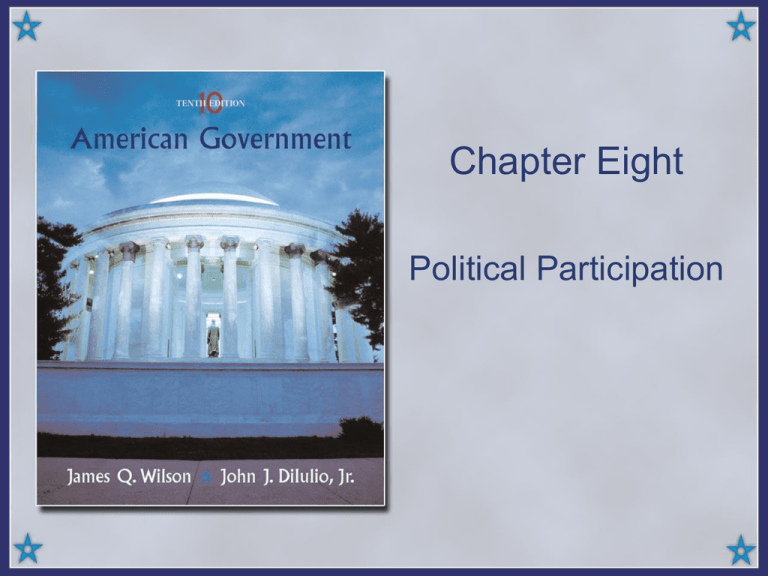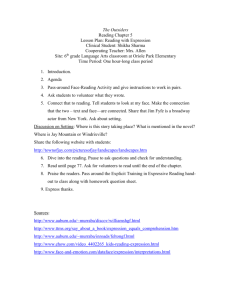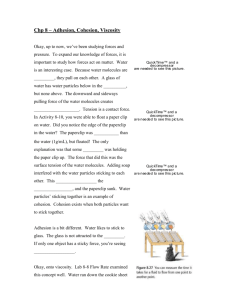
Chapter Eight
Political Participation
Objectives
• This chapter reviews the much-discussed lack of voter turnout and of other
forms of political participation in the United States. After reading and
reviewing the material in this chapter, the student should be able to do each
of the following:
• Explain why the text believes that the description, the analysis, and many of
the proposed remedies for low voter turnout rates in the United States are
Quic kTime™ and a
generally off base.
TIFF
(Unc ompres sed) dec ompres sor
• Compare the way that turnout statistics are tabulated for the United States
are
toexplain
seethetsignificance
his picofture.
and forneeded
other countries, and
these differences.
• Describe how control of the elections has shifted from the states to the
federal government, and explain what effect this shift has had on Blacks,
women, and youth.
• State both sides of the debate over whether voter turnout has declined over
the past century, and describe those factors that tend to hold down voter
turnout in the United States.
• Discuss those factors that appear to be associated with high or low political
participation.
Copyright © Houghton Mifflin Company. All rights reserved.
8|2
THEME A: POPULAR PARTICIPATION IN ELECTIONS
From State to Federal Control
• Initially, states decided who could vote and
for whichQuic
offices
kTime™ and a
TIFF
(Unc
dec
• This
ledompres
to wide sed)
variation
inompres
federal sor
are needed to see t his pic ture.
elections
• Congress has since reduced state
prerogatives through law and constitutional
amendments
Copyright © Houghton Mifflin Company. All rights reserved.
8|3
Expanding the Franchise
• 1842 law: House members elected by
district
• 15th Amendment
(1870):and
seemed
Quic kTime™
a to give
TIFFsuffrage
(Unc ompres
sed)
dec ompres sor
to African
Americans
arethneeded to see t his pic ture.
• 19 Amendment (1920): Women given
suffrage
• 26th Amendment (1971): 18-year-olds given
suffrage
Copyright © Houghton Mifflin Company. All rights reserved.
8|4
Table 6.2: Voter Registration in the South
Quic kTime™ and a
TIFF (Unc ompres sed) dec ompres sor
are needed to see t his pic ture.
Copyright © Houghton Mifflin Company. All rights reserved.
8|5
Nonvoting
• Alleged problem: low turnout of voters in
the U.S. compared to Europe
• Data is misleading:
it tends
Quic kTime™
andtoacompare
TIFFturnout
(Unc ompres
sed) dec
ompres sor
of the voting-age
population;
are
needed
to seevoters
t his pic
ture.the
turnout
of registered
reveals
problem is not so severe
• The real problem is low voter registration
rates
Copyright © Houghton Mifflin Company. All rights reserved.
8|6
Figure 8.2: Voter Participation in
Presidential Elections, 1860-2004
Quic kTime™ and a
TIFF (Unc ompres sed) dec ompres sor
are needed to see t his pic ture.
For 1860-1928: Bureau of the Census, Historical Statistics of the United States, Colonial Times to 1970, part 2, 1071; 19321944: Statistical Abstract of the United State, 1992, 517; 1948-2000: Michael P. McDonald and Samuel L. Popkin, "The Myth
of the Vanishing Voter," American Political Science Review 95 (December 2001): table 1, 966.
Copyright © Houghton Mifflin Company. All rights reserved.
8|7
Table 8.3:
Two Methods
of Calculating
Quic kTime™ and a
TI
FF (Uncinompres sed) dec ompres sor
Turnout
are needed to see t his pic ture.
Presidential
Elections,
1948-2000
Copyright © Houghton Mifflin Company. All rights reserved.
8|8
Table 6.4: Two Methods of Calculating Voter
Turnout in Selected States, 2000
Quic kTime™ and a
TIFF (Unc ompres sed) dec ompres sor
are needed to see t his pic ture.
Copyright © Houghton Mifflin Company. All rights reserved.
8|9
Table 6.1:
Two Ways of
Calculating
Voter Quic kTime™ and a
TIFF
(Unc ompres sed) dec ompres sor
Turnout,
are needed to see t his pic ture.
1996-2001
Elections,
Selected
Countries:
Copyright © Houghton Mifflin Company. All rights reserved.
8 | 10
Figure 6.1: Sources of Voter Registration
Applications, 1999-2000
Quic kTime™ and a
TIFF (Unc ompres sed) dec ompres sor
are needed to see t his pic ture.
• Source: Federal Election Commission, Executive
Summary--Report
to the Congress, 2000.
Copyright
© Houghton Mifflin Company. All rights reserved.
8 | 11
Voter Turnout
• Real decline is caused by lessening
popular interest and decreasing party
mobilization
Quic kTime™ and a
TIFF (Unc ompres sed) dec ompres sor
•are
Some
scholars
voter
needed
toargue
see thistorical
his pic ture.
turnout figures where skewed by fraud
• Most scholars see some real decline due to
several causes, including the difficulty of
registration
Copyright © Houghton Mifflin Company. All rights reserved.
8 | 12
Discussion Questions for Theme A
• What have been the policy consequences of a broader
electorate? Which extensions of the suffrage have
changed policy outcomes, and which have mattered
little?
• What couldQuic
be done
to increaseand
voter a
turnout? Would a
kTime™
reforms to
increase
voting
turnout sor
need to
TIFFprogram
(Unc of
ompres
sed)
dec
ompres
focusneeded
on the cost of
benefits,
or both?
are
tovoting,
see the
t his
pic ture.
Which do current reform proposals do?
• Why not simply make voting compulsory? If you do
not want to use coercion to induce voting, why not pay
people to vote? If elections are a public good in which
all citizens have a stake, why should we depend on
unpaid voluntary action?
Copyright © Houghton Mifflin Company. All rights reserved.
8 | 13
THEME B: POLITICAL PARTICIPATION AND VOTING
Six Kinds of US Citizens
• Inactives: rarely vote, contribute to political
organizations, or discuss politics; have little
education, low income, young, many blacks; 22
Quic kTime™ and a
TIFFpercent
(Unc ompres sed) dec ompres sor
needed
to see
hisdopic
ture.
•are
Voting
specialists:
vote tbut
little
else; not
much education or income, older
• Campaigners: vote, get involved in campaign
activities, more educated, interested in politics,
identify with a party, take strong positions
Copyright © Houghton Mifflin Company. All rights reserved.
8 | 14
Six Kinds of US Citizens
• Communalists: nonpartisan community activists
with a local focus
• ParochialQuic
participants:
don’t
vote
kTime™
and
a or participate
campaigns
or political
but
do
TIFFin(Unc
ompres
sed) organizations,
dec ompres
sor
are
needed
to about
see specific
t his pic
ture.
contact
politicians
problems
• Activists: Participate in all forms of politics;
highly educated, high income, middle age; 11
percent
Copyright © Houghton Mifflin Company. All rights reserved.
8 | 15
Table 8.5: How Citizens Participate
Quic kTime™ and a
TIFF (Unc ompres sed) dec ompres sor
are needed to see t his pic ture.
Copyright © Houghton Mifflin Company. All rights reserved.
8 | 16
Predictors of Participation
• Those with schooling or political information
are more likely to vote
Quic kTime™
a
• Church-goers
vote more,and
because
church
TIFF (Unc ompres sed) dec ompres sor
involvement
associated
are
neededdevelops
to see tthe
hisskills
pic ture.
with political participation
• Men and women vote at the same rate
Copyright © Houghton Mifflin Company. All rights reserved.
8 | 17
Predictors of Participation
• Black participation is lower than that of
whites overall
Quic
and astatus,
• Controlling
forkTime™
socioeconomic
TIFF (Unc ompres sed) dec ompres sor
blacks
participate
at athigher
than
are
needed
to see
his picrate
ture.
whites
• Studies show no correlation between
distrust of political leaders and not voting
Copyright © Houghton Mifflin Company. All rights reserved.
8 | 18
Figure 6.4: Voter Turnout in Presidential
Elections, by Age, Schooling, and Race,
1964-1996
Quic kTime™ and a
TIFF (Unc ompres sed) dec ompres sor
are needed to see t his pic ture.
• Source: Updated from Gary R. Orren, "The Linkage of
Policy to Participation," in Presidential Selection, ed.
Copyright © Houghton Mifflin Company. All rights reserved.
8 | 19
Figure 8.5: Electoral/Nonelectoral Political
Participation Among Anglo Whites,
African Americans, and Latinos
Quic kTime™ and a
TIFF (Unc ompres sed) dec ompres sor
are needed to see t his pic ture.
Adapted from Sidney Verba, Kay Lehman Scholzman, Henry Brady, and Norman H. Nie, Voice
and Equality: Civic Voluntarism in American Politics, (Cambridge: Harvard University Press, 1995).
Copyright © Houghton Mifflin Company. All rights reserved.
8 | 20
Factors That Decrease Turnout
• More youths, blacks, and other minorities in
population are pushing down the
percentage
ofkTime™
eligible adults
Quic
and who
a are
and vote
TIFFregistered
(Unc ompres
sed) dec ompres sor
needed
to effective
see t his
ture.
•are
Parties
are less
inpic
mobilizing
voters
• Remaining impediments to registration
have some discouraging effects
Copyright © Houghton Mifflin Company. All rights reserved.
8 | 21
Factors That Decrease Turnout
• Voting is not compulsory, as it is in some
other nations
Quic kTime™
and
a that
• Some potential
voters may
feel
TIFF (Unc ompres sed) dec ompres sor
elections
do not
are
needed
to matter
see t his pic ture.
Copyright © Houghton Mifflin Company. All rights reserved.
8 | 22
Participation Other Than Voting
• People can give money to a candidate
• They can join political organizations
Quic
kTime™
and
a variety of
•
Citizens
also
engage
in
a
wide
TIFF (Unc ompres sed) dec ompres sor
nonpolitical
are
neededactivities
to see t his pic ture.
Copyright © Houghton Mifflin Company. All rights reserved.
8 | 23
Figure 8.3: Nonpolitical Voluntary Activity
Among Citizens
Quic kTime™ and a
TIFF (Unc ompres sed) dec ompres sor
are needed to see t his pic ture.
Sidney Verba et al., Voice and Equality: Civic Volunteerism in American
Politics (Cambridge: Harvard University Press, 1995), 77-79.
Copyright © Houghton Mifflin Company. All rights reserved.
8 | 24
Table 8.6: Participation Beyond Voting in
Fourteen Democracies
Quic kTime™ and a
TIFF (Unc ompres sed) dec ompres sor
are needed to see t his pic ture.
Copyright © Houghton Mifflin Company. All rights reserved.
8 | 25
What Participation Rates Mean
• Americans vote less, but participate more
• Americans elect more officials and have
Quic kTime™ and a
more elections
TIFF (Unc ompres sed) dec ompres sor
•are
U.S.needed
turnout rates
are theavily
to see
his picskewed
ture. to
higher status persons
Copyright © Houghton Mifflin Company. All rights reserved.
8 | 26
Discussion Questions
• Which of these ten measures do you believe would be
the most appealing to the American public, given
current participation patterns? Which proposals would
be the most objectionable?
Quic kTime™
and state,
a and federal
• Would an increase
in voting in local,
TIFF
(Unc be
ompres
dec of
ompres
sorof
elections
a logical sed)
consequence
the adoption
are
needed
toWhy
see
t hisnot?
pic ture.
Barber’s
proposals?
or why
• How can technological change be used to increase
political participation? Or do you expect innovations
in information and communication to discourage
participation?
Copyright © Houghton Mifflin Company. All rights reserved.
8 | 27


